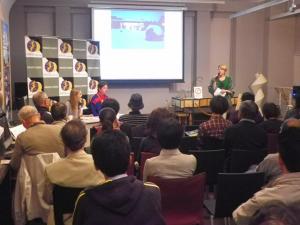
Report on the Open Seminar °∆The situation and prospects for Saami Culture in Finland°«
2012/05/26
On the 26th of May, 2012, the Information Exchange Corner at the Hokkaido University Museum hosted an Open Seminar on °∆The situation and prospects for Saami Culture in Finland°«. This seminar is the first of seven that will be held in conjunction with the °»Communication in the Arctic, the Saami across the Borders°… exhibition that opened at the Museum the previous day. After an Introduction provided by Martina Tyrisevä, Head of the Finnish Institute in Japan°«s Hokkaido Office, a lecture was given by the Saami Museum Director, Tarmo Jomppanen, on the current state of Saami culture.
Mr. Jomppanen opened his talk with a story of about how, amongst the materials held by the Museum of Northern Peoples in Abashiri, he came across items crafted by his Grandfather. The bulk of his time, though, was allocated to the current state of the Saami language and efforts to support it, as the ability to speak Saami is particularly central to their ethnic identity. With over two-thirds of the Saami resident outside their indigenous territory and with the younger generation not necessarily acquiring Saami as their mother tongue, he introduced efforts to revive its usage through universities and internet radio. He also introduced various activities of the community like the Saami Parliament, Saami museum and running specialist tours. Questions were asked on the Saami language, the aims of the museum, how indigenous people viewed tourism and comparisons with the Ainu situation. Given his experience, Mr. Jomppanen°«s talk provided many useful suggestions for the maintenance and development of the cultures of indigenous peoples. Those who wish to know more about the Saami should consult the websites below:
 Saami Parliament Homepage
Saami Parliament Homepage
Saami Museum Homepage

Mr. Jomppanen opened his talk with a story of about how, amongst the materials held by the Museum of Northern Peoples in Abashiri, he came across items crafted by his Grandfather. The bulk of his time, though, was allocated to the current state of the Saami language and efforts to support it, as the ability to speak Saami is particularly central to their ethnic identity. With over two-thirds of the Saami resident outside their indigenous territory and with the younger generation not necessarily acquiring Saami as their mother tongue, he introduced efforts to revive its usage through universities and internet radio. He also introduced various activities of the community like the Saami Parliament, Saami museum and running specialist tours. Questions were asked on the Saami language, the aims of the museum, how indigenous people viewed tourism and comparisons with the Ainu situation. Given his experience, Mr. Jomppanen°«s talk provided many useful suggestions for the maintenance and development of the cultures of indigenous peoples. Those who wish to know more about the Saami should consult the websites below:
 Saami Parliament Homepage
Saami Parliament HomepageSaami Museum Homepage







